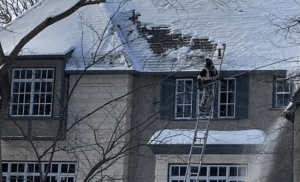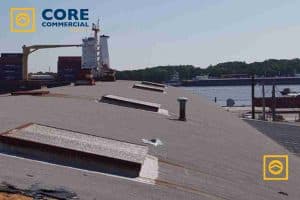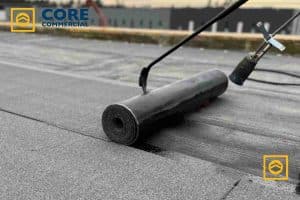Ponding water on commercial roofs can quickly lead to structural damage, leaks, and costly repairs. The ultimate defense is proper drainage design and proactive maintenance. Core Commercial Roofing & Coatings specializes in long-term, pond-free roofing systems that keep your investment protected for years to come.
Below are six proven strategies to eliminate standing water and extend the life of your roof – including the industry gold standard: a tapered insulation system.
Table of Contents
What Causes Ponding Water on Commercial Roofs?
Flat and low-slope roofs are common across commercial buildings in Texas because they offer efficient use of space and easy access for maintenance and rooftop equipment – not because they’re cheap. These systems require precision in design and drainage to perform well over time.
Without proper slope or a well-maintained drainage system, rainwater can collect in low spots and depressions.
Common causes of ponding include:
- Insufficient slope or poor roof design
- Clogged gutters or internal drains
- Debris buildup (leaves, dirt, or dust)
- Sunken or warped insulation
- Damaged or aging roof materials
If left unaddressed, ponding can deteriorate membranes, compromise insulation, and eventually cause structural leaks that require major repairs.
Why Roof Drainage Matters in Texas
Texas weather is unpredictable – heavy rains, wind-driven storms, and long stretches of heat put added stress on roofing systems. Standing water might seem harmless at first, but it’s one of the most damaging conditions for a flat roof.
Poor drainage can:
- Weaken membranes and open seams
- Add excessive weight to the structure
- Create conditions for mold and bacterial growth
- Damage insulation and lower energy efficiency
- Lead to interior leaks and ceiling damage
Since full roof replacements are expensive and disruptive, drainage design and maintenance should always be a top priority. Preventing ponding from the start is the best way to protect your investment.
Our Top Solution: Tapered Roofing Systems
If you want a long-term fix for ponding, a tapered insulation system is the best solution available. These systems use layers of ISO insulation boards cut at an angle – typically sloped between 1/8″ and 1/4″ per foot – to create proper water flow on an otherwise flat deck.
Benefits of a tapered system:
● Directs water efficiently toward drains and scuppers
● Improves drainage without altering building structure
● Reduces risk of ponding in problem areas
● Increases energy efficiency and R-value in thicker sections
● Helps roofs meet building code and warranty requirements
In areas with heavy and sudden rainfall, like much of Texas, a properly designed tapered system ensures your roof stays drier, safer, and longer-lasting.
How to Spot Early Warning Signs of Drainage Trouble
The best time to fix ponding problems is before they turn into leaks. Regularly checking your roof can help catch early warning signs.
Watch for these red flags:
● Shiny or dark patches that remain wet 48+ hours after rainfall
● Water stains or mold on interior ceilings
● Pools of water around HVAC units or drains
● Algae or moss growth
● Loose seams, cracks, or bubbles in the membrane
If you spot any of these, schedule a professional inspection right away to prevent further damage.

Routine Roof Inspections That Actually Work
You don’t have to wait for a problem to inspect your roof. Preventative inspections are one of the best investments you can make.
Recommended schedule:
● Twice per year – once in spring and once in fall
● After major storms or hail events
● Whenever you notice moisture or leaks inside
During inspections, focus on:
● Drains, scuppers, and downspouts (check for clogs or damage)
● Flat or sagging sections of the roof
● Seams, flashing, and terminations
● Debris accumulation
Professional contractors can also perform infrared moisture scans to detect trapped water beneath the membrane – something that’s invisible to the naked eye.
Upgrading Your Roof’s Drainage System
Even if your roof already has drains and gutters, older systems may not handle today’s rainfall patterns.
A few smart upgrades can make a big difference in performance:
● Add additional internal drains in low-lying areas
● Install larger scuppers or overflow outlets for faster drainage
● Widen or replace gutters and downspouts to handle heavier storms
● Use strain relief screens or strainers to prevent blockages
● Incorporate secondary drainage systems as emergency backups
According to code, most low slope roofs should have a minimum slope of ¼ inch per foot toward drains or scuppers. Meeting that standard helps prevent ponding beyond 48 hours – a key warranty and performance requirement.
The Power of Roof Coatings for Water Management
Roof coatings aren’t drainage systems, but they play a major role in protecting the membrane from Texas heat and moisture.
Popular options include:
● Silicone coatings: Excellent resistance to ponding water and UV rays
● Acrylic coatings: Great UV protection for hot, sunny climates
● Polyurethane coatings: Superior durability and impact resistance
When applied correctly, coatings add a seamless, waterproof layer that extends roof life, reduces energy costs, and protects against leaks. Silicone coatings in particular are ideal for flat roofs that experience temporary standing water.
Keep Drains and Gutters Clear
Even the best drainage design fails if it’s clogged. Wind, dust, and debris buildup are common in Texas and can quickly block flow paths.
Include debris removal in your quarterly maintenance plan:
- Clear leaves, dirt, and debris from roof surfaces
- Clean and check drain covers and scuppers
- Flush gutters and downspouts to remove blockages
These small steps go a long way in preventing costly repairs later.
Benefits of Investing in Proper Drainage
Upgrading or maintaining your drainage system pays off in every way.
Long-term benefits include:
● Extending roof life by 5–10 years or more
● Reducing leaks, emergency calls, and insurance claims
● Improving energy efficiency
● Preventing downtime and business disruption
● Protecting your property value
Whether it’s through a tapered system, better drainage design, or routine maintenance – every improvement strengthens your roof’s performance and longevity.
Final Thoughts: Build a Pond-Free Roof
Standing water is more than an eyesore, it’s an early warning sign. By addressing ponding immediately, you can prevent leaks, protect your building, and save thousands in future repairs.
Start by identifying problem areas early, invest in proper drainage design, and schedule
consistent maintenance. With expert guidance and reliable systems, you can keep your roof performing like new – rain or shine.
FAQ
What causes water to pool on flat roofs in Texas?
Ponding is typically caused by inadequate roof slope or poor design, which allows rainwater to collect in low, uneven spots. A reliable commercial roofing contractor like Core Commercial Roofing & Coatings can perform a comprehensive roof survey and use infrared scanning to pinpoint the exact locations where ponding is occurring, including areas where water has saturated the underlying insulation. Other common causes are clogged drains, structural sagging (deck deflection) over time due to the weight of rooftop equipment like HVAC units, and warped materials.
How can I stop ponding water on my commercial roof?
The most effective long-term solution is installing a tapered roofing system to create a slight, permanent slope that guides water to the drains. Core Commercial Roofing & Coatings specializes in designing and installing these customized tapered systems, ensuring the water runoff meets or exceeds the necessary minimum slope of $1/4$ inch per foot. If a full replacement isn’t feasible, immediate actions include clearing debris and fixing clogged drains.
Is ponding water harmful to my building's roof?
Yes, it is very harmful. Standing water, defined as water remaining for more than 48 hours, accelerates the degradation of your roof membrane and seams, leading to leaks. It also imposes a huge structural strain—just 1 inch of water weighs over $5\text{ lbs/ft}^2$—and often voids the manufacturer’s warranty. Addressing this immediately, possibly with an inspection from Core Commercial Roofing & Coatings, is crucial to prevent structural damage, energy loss, and the growth of mold or mildew.
How often should I inspect my commercial roof?
You should have a professional inspection at least twice per year (spring and fall) and always after major weather events (like hailstorms or severe thunderstorms). These routine checks help catch minor drainage issues early. Core Commercial Roofing & Coatings offers detailed maintenance programs that include photo-documented reports and critical checks of all drainage components to prevent costly emergencies.
What are the best drainage solutions for flat roofs?
The best strategy combines proactive design with robust hardware. The top solution is a tapered roofing system that permanently corrects the slope issue. Secondly, upgrading to larger scuppers or adding overflow drains provides essential backup for handling sudden, intense rainfall, common in Texas. Finally, ensuring all internal drains and scuppers are covered with functional strainers prevents clogs.
Can roof coatings help prevent water pooling?
Yes, a high-quality roof coating is an excellent measure against ponding. Specifically, silicone coatings are hydrophobic (water-repelling), which means they resist the degradation caused by constant standing water-unlike acrylics. This protective, seamless layer is one of the effective restoration services offered by Core Commercial Roofing & Coatings to extend roof life and minimize water damage without a full tear-off.
What are signs of drainage problems on a roof?
Exterior Signs:
1. Visible pools of water still present 48 hours after the rain stops.
2. Heavy algae, moss, or thick dirt buildup in low-lying areas.
3. Visible sagging or “dishing” of the roof membrane, often near HVAC units.
Interior Signs:
4. Water stains or streaks on the ceiling or walls, or a musty odor, indicating a progressed leak. If you see these red flags, contact an expert for a thorough drainage assessment.
How does Texas weather affect flat roof drainage?
Texas weather involves both high-intensity, sudden rain events and long periods of extreme heat and UV exposure. The intense rainfall quickly overwhelms standard-sized drains, causing flash ponding. The subsequent high temperatures then rapidly break down materials weakened by the standing water. This harsh cycle makes superior, ponding-resistant systems, like a correctly installed tapered roof, essential.
Why is regular roof maintenance important?
Maintenance is your primary defense against costly failure. It allows for the low-cost correction of small issues before they become catastrophic, a service often provided through maintenance agreements with companies like Core Commercial Roofing & Coatings. This proactive approach is vital because most manufacturers require documented, regular maintenance to keep your warranty valid. Key tasks include quarterly clearing of all drainage systems and identifying minor membrane damage.
What is tapered insulation, and how does it help?
Tapered insulation is a system of rigid foam boards (like Polyiso) that are factory-cut with a specific incline, typically a pitch of $1/4$ inch per foot. When installed, these boards create an integrated, positive slope across the roof deck, forcing water to flow directly to the drains. This permanent, structural-grade solution eliminates the flat spots that cause ponding, providing superior long-term performance and meeting strict building codes.






